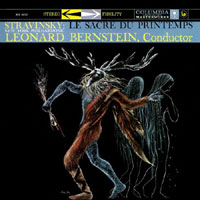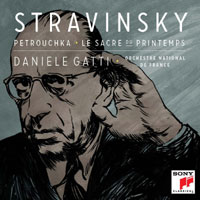Stravinsky • Le Sacre du Printemps
Stravinsky • Petrouchka, Le Sacre du Printemps
wo thousand thirteen represents the centenary anniversary of the first performance of Igor Stravinsky's revolutionary work Le Sacre du Printemps (The Rite of Spring). This work premiered in May 1913 at the beautifully designed and constructed Paris opera house, Theatre des Champs-Elysees, Pierre Monteux conducting the Orchestre National de France. Counted among the patrons in attendance that evening were such luminaries as Pablo Picasso, Marcel Proust, Gertrude Stein, Camille Saint-SaŽns, and other distinguished members of Parisian society. As the music and dancing unfolded during roughly the first twenty minutes or so of the performance, several in the audience began to stir in their seats, particularly during the "Sacrificial Dance" section in the second half of Le Sacre. Within minutes, audience members began to voice their disapproval at what they were hearing and seeing; an agitated crowd began to bellow vociferously with catcalls, grunts, growls and physical displays of finger-pointing at their reaction to sounds of dissonance, the work's ritual paganism, and arbitrary vulgarity that people conceived prior to the work's conclusion. Unseating themselves, they headed toward the exits as an expression of their discontent and disapproval. It must have been quite an evening for patrons who were accustomed to the musical delights of earlier Russian composers of the Romantic period. Reports in the press the following day recounted an outcry by the general public, with commentaries highlighting disbelief and disillusion to the earlier evening's experience. Most of the diatribes were aimed not only toward Stravinsky and Diaghilev, the producer-director of the Ballets Russes company, but particularly at Nijinsky, who designed the choreography for the program. Curiously, with all the din and confusion in the opera house, Stravinsky, Diaghilev and Nijinsky fled the building to find solace and comfort in the Bois du Boulogne, where apparently they meditated on the possible reasons a dissident crowd should project their salvos.The event brought a new dawn to early twentieth-century classical music, aurally and visually, to the violent, galvanizing, even savage-sounding chords, triads and rhythms in a major venue for the performing arts. The two discs for discussion here represent the remastering of Bernstein's 1958 Columbia Masterworks recording of Le Sacre held during a one-day studio taping at the renowned St. George Hotel in Brooklyn, NY, with the New York Philharmonic -- some blocks away from the same neighborhood where I grew up and attended school through college -- and Daniele Gatti's 2011 recordings of both Le Sacre and Petrouchka with the Orchestre National de France. Bernstein would later record Le Sacre with the London Symphony Orchestra in 1972, and with the Israel Philharmonic in 1982. He also recorded Petrouchka several times during his illustrious career with various ensembles and on different recording labels. Many musicologists consider Le Sacre to be among the most influential compositions ever written based of its continuous popularity with audiences, a fact which perhaps substantiates that it is Stravinsky's most recorded and transcribed work. A small case in point may illustrate its inherent beauties. I remember hearing for the first time an abridged version of Le Sacre when I saw Leopold Stokowski conduct the Philadelphia Symphony Orchestra in Disney's remarkable 1940 film Fantasia, which in its time was a superb cinematic achievement, an eight-part marriage of music and animation. Hollywood also incorporated some of Stravinsky's music on the soundtracks of the old Tom and Jerry cartoons that became favorites among people of all ages. Nowadays Le Sacre is mostly performed as an orchestral showpiece and not a ballet. Early on, Bernstein was attracted to the piece, whose subtitle is "Scenes from Pagan Russia in Two Parts." The first half of the score is headed "Adoration of the Earth" and the second and most dramatic half bears the name "The Sacrifice." In this composition Bernstein enjoyed its spirit and brisk tempos, but also the interplay of the instrumentation with which he could create an arresting tension and exuberance. Basically, the story entails a pagan rite in which wise elders seated in circular formation on a stage watch a young girl dance herself nearly to death. These men intend to sacrifice her to propitiate the god of spring -- a primary theme of the opus. Each unfolding scene reflects an emotion of solemnity, alternating with terrestrial pleasure and a reactionary sensibility of human fright. As the ballet develops, the young woman dances helter-skelter before selecting a victim for whom the dancers intend ultimately to honor, but the elders decide instead to sacrifice her to appease the deity Yarilo. In Bernstein's 1958 version, which is heard in more vivid sound in the reissue, he devotes considerable attention to the bass, woodwinds, drums and cellos to create an aura of impending doom. One can imagine the performers dancing vigorously across the stage accompanied by blasts of instrumentation combined with the cacophony of thunder roaring overhead during the sacrificial scene. My only caveat is that you can hear some hissing in the transfer, but I was not disturbed by it. Gatti's new recording does not have any sonic problems, and he too manages to raise one's adrenaline level when he brings his orchestra full throttle to fulfill his musical insights. While Bernstein could impart a sense of introspective and even ardent momentum to conducting Stravinsky, Gatti, especially in his version of Petrouchka, seems to let the music speak for itself, even to the point of slowing down the musical ride so to speak, alternating between polished feelings he derives from Stravinsky's score and his own perception of rhythm and melodic subtlety that his French orchestra could easily execute. Born in Milan in 1961, Gatti has conducted operas and symphonic works, exhibiting a preference and flair for late-19th- and early-20th-century composers: to wit, Tchaikovsky, Wagner, Mahler, Bartůk, Prokofiev, Respighi and others. Named the conductor of the Orchestre National de France in 2009, he has appeared before audiences largely in Europe, England and the United States. In his 2011 interpretations of Le Sacre and Petrouchka, he appears to enjoy the visceral, raw power and rhythmic intensity of Le Sacre, whereas in Petrouchka he takes a leisurely approach to the ballet that portrays the adventures of a bright, brash and bold puppet suddenly brought to life. Gatti's style here is to take measured steps to evoke Stravinsky's music by emphasizing sounds for sheer musical goals rather than the beauty itself in the overall depiction of the life and times of the central character. In addition, he does not stray at all to unearth other possible tweaks in the music that seemingly do not exist for him as they did Bernstein, whose approach in both the 1911 version as well as the composer's own revision in 1947 closes in more clearly to the work's originality and iconoclasm. Bernstein had long enjoyed the theater, concert and opera halls where he could display his talent and love for the music that made a large imprint on his raison d'etre. As a young man, I recall his television series Young People's Concerts, in which he entertained primarily a younger audience interested in learning about classical music. His nearly biblical knowledge and conducting skills delighted his viewers for years. At the Berkshire Music Center in Tanglewood, Bernstein served as an adviser and teacher of young talented people who would share his enthusiasm and learn the maestro's craft. Bernstein and Stravinsky would often talk with each other about the latter's keen interest in neoclassicism, polytonality, and on occasion aspects of jazz and popular music. Today there are more than three dozen reference-grade recordings of Le Sacre, and while it is difficult to choose the best, should that version exist, much can be written about excellent recordings by Markevitch and Boulez, Stravinsky's 1960 interpretation, and more recently the powerful interpretation by Gergiev and his Kirov orchestra. Regarding Petrouchka, Gatti is fine, but I give a nod to Tilson Thomas, who delivers a wonderful recording with his superb San Francisco musicians -- a perfect example of hitting all the details in the score. Both Bernstein's and Gatti's discs are worthy of any
collection of Stravinsky's great musical repertory. The engineering is fine and much
pleasure can be derived from the beautiful clarity of tone, timbre and acoustic presence
of each orchestra in performing Russian-inspired music as penned by arguably that
country's foremost composer of his day. |


